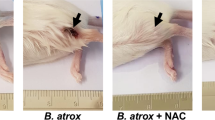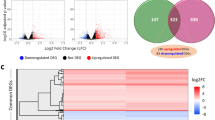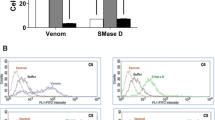Abstract
The spiders of the Loxosceles genus (called brown or violin spiders) are of medical relevance in several countries due to the many human envenomation cases reported. The main component of Loxosceles venom is the enzyme sphingomyelinase D (SMase D), which is responsible for the local and systemic effects induced by the whole venom. Here, we investigated the cytotoxic and genotoxic effects caused by Loxosceles laeta venom and SMase D on human keratinocytes to better understand the dermonecrosis development mechanism. Our findings indicate that whole venom, as well as SMase D, increases intracellular superoxide levels, leading to DNA damage. These effects appear to be dependent on the binding of SMase D to the cell surface, although the complete pathway triggered as a result of the binding still needs to be elucidated. Moreover, after SMase D treatment, we observed the presence of histone γH2AX, suggesting that the cells are undergoing DNA repair. Moreover, when ATR kinase was inhibited, the cell viability of human keratinocytes was decreased. Together, our findings strongly suggest that L. laeta venom, as well as SMase D, increases intracellular superoxide levels, leading to DNA damage in human keratinocytes. Additionally, the induced DNA damage is repaired through the activation of an apparent ATR-mediated DNA-damage response. This knowledge may contribute to a better understanding of the behaviour of human keratinocytes during cutaneous loxoscelism, a condition that affects thousands of people around the world.







Similar content being viewed by others
Availability of data and material
All datasets of this work are presented in the main manuscript.
References
Andrieu-Abadie N, Levade T (2002) Sphingomyelin hydrolysis during apoptosis. Biochim Biophys Acta Mol Cell Biol Lipids 1585:126–134
Anwar S, Torosyan R, Ginsberg C et al (2013) Clinicopathological course of acute kidney injury following brown recluse (Loxoscles reclusa) envenomation. Clin Kidney J 6:609–612. https://doi.org/10.1093/ckj/sft111
Bernardshaw S, Lyberg T, Hetland G, Johnson E (2007) Effect of an extract of the mushroom Agaricus blazei Murill on expression of adhesion molecules and production of reactive oxygen species in monocytes and granulocytes in human whole blood ex vivo. APMIS 115:719–725. https://doi.org/10.1111/j.1600-0463.2007.apm_619.x
Binford GJ, Cordes MHJ, Wells MA (2005) Sphingomyelinase D from venoms of Loxosceles spiders: evolutionary insights from cDNA sequences and gene structure. Toxicon 45:547–560. https://doi.org/10.1016/j.toxicon.2004.11.011
Bucherl W (1969) Biology and venoms of the most important soutli american spiders of the genera Phoneutria, Loxosceles, Lycosa, and Latrodectus. Integr Comp Biol 9:157–159. https://doi.org/10.1093/icb/9.1.157
Burma S, Chen BP, Murphy M et al (2001) ATM phosphorylates histone H2AX in response to DNA double-strand breaks. J Biol Chem 276:42462–42467. https://doi.org/10.1074/jbc.C100466200
Cachia M, Mercieca L, Mallia Azzopardi C, Boffa MJ (2016) Rare case of dermonecrosis caused by a recluse spider bite in Europe. BMJ Case Rep. https://doi.org/10.1136/bcr-2016-215832
Cannan WJ, Tsang BP, Wallace SS, Pederson DS (2014) Nucleosomes suppress the formation of double-strand DNA breaks during attempted base excision repair of clustered oxidative damages. J Biol Chem 289:19881–19893. https://doi.org/10.1074/jbc.M114.571588
Chan K, Sterling JF, Roberts SA et al (2012) Base damage within single-strand DNA underlies in vivo hypermutability induced by a ubiquitous environmental agent. PLoS Genet. https://doi.org/10.1371/journal.pgen.1003149
Chatterjee S (1999) Neutral sphingomyelinase: past, present and future. Chem Phys Lipids 102:79–96. https://doi.org/10.1016/S0009-3084(99)00077-8
Corrêa MA, Okamoto CK, Gonçalves-De-andrade RM et al (2016) Sphingomyelinase D from Loxosceles laeta venom induces the expression of MMP7 in human keratinocytes: contribution to dermonecrosis. PLoS ONE. https://doi.org/10.1371/journal.pone.0153090
Cui Y, Palii SS, Innes CL, Paules RS (2014) Depletion of ATR selectively sensitizes ATM deficient human mammary epithelial cells to ionizing radiation and dna-damaging agents. Cell Cycle 13:3541–3550. https://doi.org/10.4161/15384101.2014.960729
D’Errico M, Teson M, Calcagnile A et al (2003) Apoptosis and efficient repair of DNA damage protect human keratinocytes against UVB [2]. Cell Death Differ 10:754–756
da Silva MS, Cayres-Silva GR, Vitarelli MO et al (2019) Transcription activity contributes to the firing of non-constitutive origins in African trypanosomes helping to maintain robustness in S-phase duration. Sci Rep 9:18512. https://doi.org/10.1038/s41598-019-54366-w
Dias MH, Fonseca CS, Zeidler JD et al (2019) Fibroblast growth factor 2 lethally sensitizes cancer cells to stress-targeted therapeutic inhibitors. Mol Oncol 13:290–306. https://doi.org/10.1002/1878-0261.12402
Fernandes Pedrosa MDF, Junqueira de Azevedo IDLM, Gonçalves-de-Andrade RM et al (2002) Molecular cloning and expression of a functional dermonecrotic and haemolytic factor from Loxosceles laeta venom. Biochem Biophys Res Commun 298:638–645. https://doi.org/10.1016/S0006-291X(02)02521-4
Flatt PM, Price JO, Shaw A, Pietenpol JA (1998) Differential cell cycle checkpoint response in normal human keratinocytes and fibroblasts. Cell Growth Differ 9:535–543
Forrester LJ, Barrett JT, Campbell BJ (1978) Red blood cell lysis induced by the venom of the brown recluse spider. The role of sphingomyelinase D. Arch Biochem Biophys 187:355–365. https://doi.org/10.1016/0003-9861(78)90046-2
Fu Y, Sies H, Lei XG (2001) Opposite roles of selenium-dependent glutathione peroxidase-1 in superoxide generator diquat- and peroxynitrite-induced apoptosis and signaling. J Biol Chem 276:43004–43009. https://doi.org/10.1074/jbc.M106946200
Furbee RB, Kao LW, Ibrahim D (2006) Brown recluse spider envenomation. Clin Lab Med 26:211–226
Futrell JM (1992) Loxoscelism. Am J Med Sci 304:261–267
Galvani NC, Vilela TC, Domingos AC et al (2017) Genotoxicity evaluation induced by Tityus serrulatus scorpion venom in mice. Toxicon 140:132–138. https://doi.org/10.1016/j.toxicon.2017.10.024
Giglia-Mari G, Zotter A, Vermeulen W (2011) DNA damage response. Cold Spring Harb Perspect Biol 3:1–19. https://doi.org/10.1101/cshperspect.a000745
Gupta SK, Shukla VK (2002) Leg ulcers in the tropics. Int J Low Extrem Wounds 1:58–61. https://doi.org/10.1177/153473460200100108
Han W, Ming M, He YY (2011) Caffeine promotes ultraviolet B-induced apoptosis in human keratinocytes without complete DNA repair. J Biol Chem 286:22825–22832. https://doi.org/10.1074/jbc.M111.222349
Isbister GK, Fan HW (2011) Spider bite. Lancet 378:2039–2047
Jackson SP, Bartek J (2009) The DNA-damage response in human biology and disease. Nature 461:1071–1078
Killar L, White J, Black R, Peschon J (1999) Adamalysins. A family of metzincins including TNF-α converting enzyme (TACE). Ann N Y Acad Sci 878:442–452. https://doi.org/10.1111/j.1749-6632.1999.tb07701.x
Krokan HE, Bjørås M (2013) Base excision repair. Cold Spring Harb Perspect Biol 5:1–22. https://doi.org/10.1101/cshperspect.a012583
Loehr JA, Abo-Zahrah R, Pal R, Rodney GG (2015) Sphingomyelinase promotes oxidant production and skeletal muscle contractile dysfunction through activation of NADPH oxidase. Front Physiol. https://doi.org/10.3389/fphys.2014.00530
Lopes PH, Murakami MT, Portaro FCV et al (2019) Targeting Loxosceles spider Sphingomyelinase D with small-molecule inhibitors as a potential therapeutic approach for loxoscelism. J Enzyme Inhib Med Chem 34:310–321. https://doi.org/10.1080/14756366.2018.1546698
Lopes PH, Squaiella-Baptistão CC, Marques MOT, Tambourgi DV (2020a) Clinical aspects, diagnosis and management of Loxosceles spider envenomation: literature and case review. Arch Toxicol. https://doi.org/10.1007/s00204-020-02719-0
Lopes PH, van den Berg CW, Tambourgi DV (2020b) Sphingomyelinases D from Loxosceles spider venoms and cell membranes: action on lipid rafts and activation of endogenous metalloproteinases. Front Pharmacol. https://doi.org/10.3389/fphar.2020.00636
Lowry OH, Rosebrough NJ, Farr AL, Randall RJ (1951) Protein measurement with the Folin phenol reagent. J Biol Chem 193:265–275. https://doi.org/10.1016/0922-338X(96)89160-4
Malaque CMS, Vetter RS, Entres M (2015) Loxosceles spiders. In: Brent J, Burkhart K, Dargan P, Hatten B, Megarbane B, Palmer R (eds) Critical care toxicology. Springer, Cham, pp 1–18. https://doi.org/10.1007/978-3-319-20790-2_119-1
Manzoni-de-Almeida D, Squaiella-Baptistão CC, Lopes PH et al (2018) Loxosceles venom Sphingomyelinase D activates human blood leukocytes: role of the complement system. Mol Immunol 94:45–53. https://doi.org/10.1016/j.molimm.2017.12.009
Marcussi S, Stábeli RG, Santos-Filho NA et al (2013) Genotoxic effect of Bothrops snake venoms and isolated toxins on human lymphocyte DNA. Toxicon 65:9–14. https://doi.org/10.1016/j.toxicon.2012.12.020
Miyake T, Shimada M, Matsumoto Y, Okino A (2019) DNA damage response after ionizing radiation exposure in skin keratinocytes derived from human-induced pluripotent stem cells. Int J Radiat Oncol Biol Phys 105:193–205. https://doi.org/10.1016/j.ijrobp.2019.05.006
Moseley R, Hilton JR, Waddington RJ et al (2004) Comparison of oxidative stress biomarker profiles between acute and chronic wound environments. Wound Repair Regen 12:419–429. https://doi.org/10.1111/j.1067-1927.2004.12406.x
Mosmann T (1983) Rapid colorimetric assay for cellular growth and cytotoxicity assays. J Immunol Methods 65:55–63
Nag A, Datta J, Das A et al (2014) Acute kidney injury and dermonecrosis after Loxosceles reclusa envenomation. Indian J Nephrol 24:246–248. https://doi.org/10.4103/0971-4065.133017
Ojha N, Roy S, He G et al (2008) Assessment of wound-site redox environment and the significance of Rac2 in cutaneous healing. Free Radic Biol Med 44:682–691. https://doi.org/10.1016/j.freeradbiomed.2007.10.056
Paixão-Cavalcante D, Van Den Berg CW, De Freitas Fernandes-Pedrosa M et al (2006) Role of matrix metalloproteinases in HaCaT keratinocytes apoptosis induced by Loxosceles venom sphingomyelinase D. J Invest Dermatol 126:61–68. https://doi.org/10.1038/sj.jid.5700049
Pezzi M, Giglio AM, Scozzafava A et al (2016) Spider bite: a rare case of acute necrotic arachnidism with rapid and fatal evolution. Case Rep Emerg Med 2016:1–4. https://doi.org/10.1155/2016/7640789
Plesca D, Mazumder S, Almasan A (2008) Chapter 6 DNA damage response and apoptosis. Methods Enzymol 446:107–122
Podhorecka M, Skladanowski A, Bozko P (2010) H2AX phosphorylation: its role in DNA damage response and cancer therapy. J Nucleic Acids 2010:920161. https://doi.org/10.4061/2010/920161
Roy S, Khanna S, Nallu K et al (2006) Dermal wound healing is subject to redox control. Mol Ther 13:211–220. https://doi.org/10.1016/j.ymthe.2005.07.684
Saari H, Suomalainen K, Lindy O et al (1990) Activation of latent human neutrophil collagenase by reactive oxygen species and serine proteases. Biochem Biophys Res Commun 171:979–987. https://doi.org/10.1016/0006-291X(90)90780-Q
Sánchez-Flores M, Pásaro E, Bonassi S et al (2015) ϒH2AX assay as DNA damage biomarker for human population studies: defining experimental conditions. Toxicol Sci 144:406–413. https://doi.org/10.1093/toxsci/kfv011
Sharma V, Collins LB, Chen TH et al (2016) Oxidative stress at low levels can induce clustered DNA lesions leading to NHEJ mediated mutations. Oncotarget 7:25377–25390. https://doi.org/10.18632/oncotarget.8298
Smith CW, Micks DW (1970) The role of polymorphonuclear leukocytes in the lesion caused by the venom of the brown spider, Loxosceles reclusa. Lab Investig 22:90–93. https://doi.org/10.1016/0041-0101(70)90216-3
Song X, Narzt MS, Nagelreiter IM et al (2017) Autophagy deficient keratinocytes display increased DNA damage, senescence and aberrant lipid composition after oxidative stress in vitro and in vivo. Redox Biol 11:219–230. https://doi.org/10.1016/j.redox.2016.12.015
Stock RP, Brewer J, Wagner K et al (2012) Sphingomyelinase D activity in model membranes: structural effects of in situ generation of ceramide-1-phosphate. PLoS ONE. https://doi.org/10.1371/journal.pone.0036003
Suzuki T, Kamiya H (2017) Mutations induced by 8-hydroxyguanine (8-oxo-7,8-dihydroguanine), a representative oxidized base, in mammalian cells. Genes Environ 39:2. https://doi.org/10.1186/s41021-016-0051-y
Tambourgi DV, Magnoli FC, Von Eickstedt VRD et al (1995) Incorporation of a 35-kilodalton purified protein from Loxosceles intermedia spider venom transforms human erythrocytes into activators of autologous complement alternative pathway. J Immunol 155:4459–4466
Tambourgi DV, Magnoli FC, Van Den Berg CW et al (1998) Sphingomyelinases in the venom of the spider Loxosceles intermedia are responsible for both dermonecrosis and complement-dependent hemolysis. Biochem Biophys Res Commun 251:366–373. https://doi.org/10.1006/bbrc.1998.9474
Tambourgi DV, Morgan BP, De Andrade RMG et al (2000) Loxosceles intermedia spider envenomation induces activation of an endogenous metalloproteinase, resulting in cleavage of glycophorins from the erythrocyte surface and facilitating complement-mediated lysis. Blood 95:683–691. https://doi.org/10.1182/blood.v95.2.683
Tambourgi DV, De Sousa Da Silva M, Billington SJ et al (2002) Mechanism of induction of complement susceptibility of erythrocytes by spider and bacterial sphingomyelinases. Immunology 107:93–101. https://doi.org/10.1046/j.1365-2567.2002.01483.x
Tambourgi DV, Paixão-Cavalcante D, Gonçalves De Andrade RM et al (2005) Loxosceles sphingomyelinase induces complement-dependent dermonecrosis, neutrophil infiltration, and endogenous gelatinase expression. J Invest Dermatol 124:725–731. https://doi.org/10.1111/j.0022-202X.2005.23654.x
Tambourgi DV, Gonçalves-de-Andrade RM, van den Berg CW (2010) Loxoscelism: from basic research to the proposal of new therapies. Toxicon 56:1113–1119
Tokumura A, Kanaya Y, Miyake M et al (2002) Increased production of bioactive lysophosphatidic acid by serum lysophospholipase D in human pregnancy. Biol Reprod 67:1386–1392. https://doi.org/10.1095/biolreprod.102.004051
Trzeciak AR, Mohanty JG, Jacob KD et al (2012) Oxidative damage to DNA and single strand break repair capacity: relationship to other measures of oxidative stress in a population cohort. Mutat Res Fundam Mol Mech Mutagen 736:93–103. https://doi.org/10.1016/j.mrfmmm.2012.01.002
Tyrrell RM (1995) Ultraviolet radiation and free radical damage to skin. Biochem Soc Symp 61:47–53
van den Berg CW, Gonçalves De Andrade RM, Magnoli FC et al (2002) Loxosceles spider venom induces metalloproteinase mediated cleavage of MCP/CD46 and MHCI and induces protection against C-mediated lysis. Immunology 107:102–110. https://doi.org/10.1046/j.1365-2567.2002.01468.x
Ward IM, Chen J (2001) Histone H2AX Is phosphorylated in an ATR-dependent manner in response to replicational stress. J Biol Chem 276:47759–47762. https://doi.org/10.1074/jbc.C100569200
Westphal CH (1997) Cell-cycle signaling: ATM displays its many talents. Curr, Biol, p 7
Wlaschek M, Scharffetter-Kochanek K (2005) Oxidative stress in chronic venous leg ulcers. Wound Repair Regen 13:452–461
Yang Y, Candelario-Jalil E, Thompson JF et al (2010) Increased intranuclear matrix metalloproteinase activity in neurons interferes with oxidative DNA repair in focal cerebral ischemia. J Neurochem 112:134–149. https://doi.org/10.1111/j.1471-4159.2009.06433.x
Yeoh-Ellerton S, Stacey MC (2003) Iron and 8-isoprostane levels in acute and chronic wounds. J Invest Dermatol 121:918–925. https://doi.org/10.1046/j.1523-1747.2003.12471.x
Zargan J, Sajad M, Umar S et al (2011) Scorpion (Androctonus crassicauda) venom limits growth of transformed cells (SH-SY5Y and MCF-7) by cytotoxicity and cell cycle arrest. Exp Mol Pathol 91:447–454. https://doi.org/10.1016/j.yexmp.2011.04.008
Acknowledgments
The authors would like to thank the São Paulo Research Foundation (FAPESP)/Center of Toxins, Immune Response and Cell Signaling (CeTICS) and the National Council for Scientific and Technological Development (CNPq) for their support.
Funding
This work was supported by FAPESP/CeTICS under grant 2013/07467-1. MSdS and PHL are fellows from FAPESP (postdoctoral fellowship grants 2014/24170-5 and 2015/17053-5, respectively). DVT and MCE are fellows from CNPq (grants 301358/2017-6 and 306199/2018-1, respectively).
Author information
Authors and Affiliations
Contributions
MSdS, PHL, MCE, and DVT conceived the rationale of the experimental design. MSdS and PHL carried out the experiments. MSdS and PHL performed statistical analyses. MSdS and PHL wrote the manuscript with essential contribution from MCE and DVT. All authors read and approved the final version of the manuscript. DVT and MCE supervised the project.
Corresponding author
Ethics declarations
Conflict of interest
The authors declare that they have no conflict of interest regarding this work.
Additional information
Publisher's Note
Springer Nature remains neutral with regard to jurisdictional claims in published maps and institutional affiliations.
Electronic supplementary material
Below is the link to the electronic supplementary material.
Rights and permissions
About this article
Cite this article
da Silva, M.S., Lopes, P.H., Elias, M.C. et al. Cytotoxic and genotoxic effects on human keratinocytes triggered by sphingomyelinase D from Loxosceles venom. Arch Toxicol 94, 3563–3577 (2020). https://doi.org/10.1007/s00204-020-02830-2
Received:
Accepted:
Published:
Issue Date:
DOI: https://doi.org/10.1007/s00204-020-02830-2




